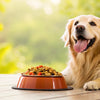Understanding What Dog Food is Good for Gaining Weight
- Houndsy
Table of Contents
- Introduction
- Why Is Weight Gain Important for Dogs?
- Signs Your Dog Might Need to Gain Weight
- Characteristics of Good Dog Food for Weight Gain
- Recommended Dog Foods for Weight Gain
- Feeding Strategies for Weight Gain
- The Role of the Houndsy Kibble Dispenser
- Conclusion
- FAQ
Introduction
Have you ever noticed your dog looking a bit too lean, perhaps with visible ribs or a prominent spine? You’re not alone in this concern—many dog owners find themselves wondering what dog food is good for gaining weight. In fact, recent studies suggest that about 30% of dogs are considered underweight at some point in their lives. This situation can be particularly concerning for pets recovering from illness, those with high energy expenditures, or even those who are naturally slim breeds.
As devoted pet parents, it’s our responsibility to ensure that our furry friends are not just healthy but also thriving. In this blog post, we'll delve into the important aspects of canine nutrition, focusing on how to help dogs gain weight safely and effectively. We’ll explore the characteristics of ideal dog foods for weight gain, discuss the role of caloric density, and provide practical tips for enhancing your dog’s diet.
By the end of this article, you will have a solid understanding of the types of dog food that can help your pet reach a healthy weight, as well as actionable steps to implement in your feeding routine. So, let’s embark on this journey to nourish our beloved companions!
Why Is Weight Gain Important for Dogs?
Before we dive into specific dog food recommendations, it’s crucial to understand why maintaining a healthy weight is important for our dogs. Just like humans, dogs can suffer from a range of health issues related to their weight. Being underweight can lead to:
- Weakened Immune System: Underweight dogs are more susceptible to infections and illnesses.
- Nutritional Deficiencies: Insufficient body fat and muscle mass can lead to overall nutrient deficiencies.
- Decreased Energy Levels: A dog lacking in weight may display lethargy and a lack of enthusiasm for exercise or play.
- Longer Recovery Times: If your dog is recovering from surgery or illness, being underweight can impede the healing process.
Therefore, ensuring that your dog is at a healthy weight is not just about aesthetics; it’s about their overall well-being and quality of life.
Signs Your Dog Might Need to Gain Weight
Before deciding on a diet change, it’s wise to assess whether your dog truly needs to gain weight. Here are some signs to look for:
- Visible Ribs and Spine: If you can easily feel your dog's ribs and spine without a layer of fat or muscle, they may be underweight.
- Tucked Abdomen: A noticeable tuck in the abdomen is a good indicator that your dog might not be at an ideal weight.
- Low Energy Levels: If your dog seems less active or playful than usual, it could be a sign that they are not getting enough calories.
If you suspect your dog is underweight, it’s always a good idea to consult with your veterinarian for a professional evaluation.
Characteristics of Good Dog Food for Weight Gain
When we’re looking for what dog food is good for gaining weight, certain characteristics stand out. Here’s what to consider:
1. High Caloric Density
The first and foremost quality to look for is caloric density. Foods that pack a lot of calories into a small serving are ideal for weight gain. Ingredients should be primarily protein and fat, as these macronutrients provide more calories than carbohydrates.
- Example: Look for foods with a caloric density of at least 400 kcal/cup.
2. High-Quality Proteins
Protein is crucial for building and maintaining muscle mass. Foods that contain high-quality animal proteins such as chicken, beef, or lamb will help your dog gain weight while supporting lean muscle development.
- Tip: Opt for dog foods that list a specific meat source as the first ingredient.
3. Healthy Fats
Fats are essential for providing the highest calorie content per gram. Look for dog foods that include healthy fats like fish oil, chicken fat, or flaxseed oil.
- Example: A good fat source should contribute at least 15-20% of the total diet for weight gain.
4. Palatability
Dogs are more likely to eat foods that are flavorful and appealing. Foods that are moist or include enticing flavors can encourage a healthy appetite, especially in picky eaters.
- Tip: Consider rotating flavors or brands to keep mealtime exciting for your dog.
5. Digestibility
Highly digestible foods ensure that your dog can absorb the nutrients efficiently, meaning they can gain weight without needing to consume excessive amounts of food.
- Indicators: Look for ingredients that are easy to digest, such as chicken meal or brown rice.
6. Low Fiber Content
While fiber is beneficial for digestion, too much fiber can reduce caloric intake. Therefore, for dogs needing to gain weight, a diet lower in fiber is preferable.
Recommended Dog Foods for Weight Gain
Now that we understand what to look for, let’s explore some dog food options that are great for helping your dog gain weight:
1. Wellness CORE Grain-Free Original Recipe
This high-protein formula includes turkey and chicken meals, providing both high-quality protein and healthy fats. Its caloric density makes it an excellent choice for weight gain.
2. Merrick Grain-Free Texas Beef & Sweet Potato Recipe
With beef as the first ingredient, this grain-free formula is also high in fat and protein, making it ideal for dogs that need to gain weight.
3. Orijen Original Dry Dog Food
Orijen is known for its high-quality ingredients and high protein content. This formula includes fresh, regional ingredients and is designed to mimic a natural diet, ensuring that your dog gets the nutrients they need to gain weight.
4. Hill's Science Diet Puppy Food
Puppy food is often higher in calories and fat than adult formulas, making it a great option for dogs that need to gain weight, regardless of their age.
5. Royal Canin Veterinary Diet Canine Recovery RS
If your dog is recovering from an illness or surgery, a veterinary diet like Royal Canin’s Recovery RS can help them regain strength and weight with its highly palatable formula.
Feeding Strategies for Weight Gain
Once you’ve chosen the right food, implementing effective feeding strategies is crucial. Here are a few tips to make the most of your dog’s weight gain journey:
1. Frequent Small Meals
Instead of feeding one or two large meals, offer multiple small meals throughout the day. This can help increase caloric intake without overwhelming your dog’s digestive system.
2. Mix Wet and Dry Food
Combining wet food with dry kibble can enhance palatability while maintaining the caloric density of the meal.
3. Healthy Toppers
Consider adding healthy toppers like boiled eggs, plain yogurt, or healthy treats to your dog’s meals for extra calories and nutrients.
4. Monitor Weight Progress
Weigh your dog weekly to track their progress. A gradual increase of about 1-2% of their body weight per week is ideal. If weight gain stalls, adjust portions or consult your vet.
5. Maintain Regular Exercise
While it may seem counterintuitive, regular exercise is important for building muscle mass. Gentle walks and play sessions can keep your dog active while they gain weight.
The Role of the Houndsy Kibble Dispenser
As we embark on our quest to help our dogs gain weight, the way we feed them plays a crucial role. Here at Houndsy, we believe in elevating the dog feeding experience. Our flagship product, the Houndsy Kibble Dispenser, is designed with convenience and modern aesthetics in mind.
With a standing height crank that eliminates the need for bending, it allows for easy portion control and reliable dispensing. The dispenser can hold between 25-30 lbs of dog food, ensuring that your pup always has access to their meals. Its BPA-free liner keeps the food fresh, while the auto-locking mechanism prevents accidental dispensing. By integrating the Houndsy Kibble Dispenser into your feeding routine, you can simplify the process of providing your dog with the right amount of food to support their healthy weight gain journey.
Conclusion
In summary, helping your dog gain weight requires a thoughtful approach to their nutrition and feeding practices. By choosing high-quality, calorie-dense dog food, maintaining a feeding schedule that promotes increased caloric intake, and monitoring your dog's progress, you can ensure that your furry friend reaches and maintains a healthy weight.
Remember, every dog is unique, and it may take some time to find the right balance for your pet. By staying attentive to their needs and being proactive in their care, we can help our beloved companions thrive.
If you’re looking for a convenient, stylish, and effective way to enhance your dog’s feeding experience, consider exploring the Houndsy Kibble Dispenser. With its innovative design and functionality, it can make the feeding process easier and more enjoyable for both you and your pet.
FAQ
What type of dog food is best for gaining weight?
Look for dog foods that are high in protein and fat, with a caloric density of at least 400 kcal/cup. Foods like Wellness CORE, Merrick Grain-Free, and Orijen are great options.
How can I tell if my dog is underweight?
You can assess your dog’s weight by checking for visible ribs, a tucked abdomen, and low energy levels. If you’re unsure, consult your veterinarian.
Should I feed my underweight dog more frequently?
Yes, feeding multiple small meals throughout the day can help increase caloric intake without overwhelming your dog’s digestive system.
Can I mix wet and dry food for my dog?
Absolutely! Mixing wet food with dry kibble can enhance the taste while maintaining the necessary caloric density.
What if my dog is not gaining weight despite a higher calorie diet?
If your dog isn’t gaining weight, consult your veterinarian. There may be underlying health issues that need to be addressed.












